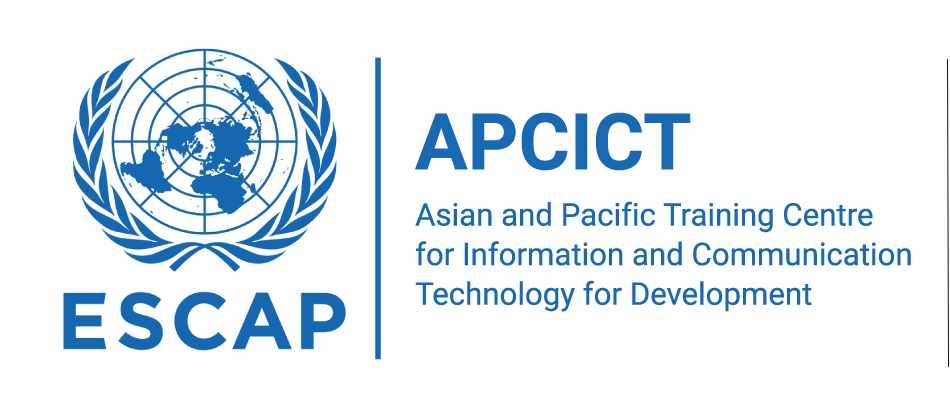UN-APCICT is compiling a series of case studies on different aspects of information and communications technology for development (ICT4D) from across the Asia-Pacific region. Two issues of the UN-APCICT Case Study Series on ICT4D will be published (in print and online) each year. Each issue will focus on one or more ICT4D theme(s). For the inaugural issue, the themes include: Technological Convergence and the New Media; e-Governance; and Gender. The deadline for submission of case studies is 31 August 2008.
Submit Case Study Online (to submit, login or register)
Email completed forms to apcict@un.org
Introduction
The United Nations Asian and Pacific Training Centre for Information and Communication Technology for Development (UN-APCICT) is compiling a series of case studies on different aspects of information and communications technology for development (ICT4D) from across the Asia-Pacific region.
The UN-APCICT Case Studies Series on ICT4D aims to share the vast body of knowledge, practical experiences and insights gained from ICT4D projects in the Asia-Pacific region. By making the project experiences and findings more accessible, the series will be a useful reference to policy makers who are planning or supporting ICT4D projects. New ICT4D projects can benefit from the case studies, avoiding common pitfalls and using strategies that have been demonstrated as successful. The case studies can also generate opportunities for networking, collaboration and implementation of new solutions.
Two issues of the UN-APCICT Case Study Series on ICT4D will be published (in print and online) each year. Each issue will focus on one or more ICT4D theme(s). For the inaugural issue, the themes include:
We are pleased to invite project managers, development practitioners, policy makers and researchers to submit case studies on these themes. The deadline for submission of case studies is 31 August 2008.
All completed case studies will be featured on UN-APCICT’s online portal - the e-Collaborative Hub (or e-Co Hub at http://www.unapcict.org/ecohub). Select case studies will be published in UN-APCICT’s bi-annual publication as part of the UN-APCICT Case Studies Series on ICT4D. Each issue will be available in print for worldwide circulation and online on UN-APCICT’s e-Co Hub for free download.
About the Case Studies
All case studies submitted must be focused on using ICT to promote social and economic development. ICTs refer to a varied set of goods, applications and services that are used to produce, store, process, distribute and exchange information. They include ‘old’ tools such as radio, television and telephone, as well as ‘new’ tools such as computers, satellite, wireless technology and the Internet.
The projects selected for the case study could be focused on addressing development issues and ICT is employed as a component in the effort. Or the focus could be on creating ICT solutions that in turn serve development goals.
Case studies on current and past projects that are of local, national or regional scales from the Asia-Pacific region will be considered. The case studies must, however, reflect and articulate the experiences, methodologies, tools used, challenges and/or lessons learned in such a way that others can learn from it.
All questions in the case study submission form must be answered in order for it to be included in the e-Co Hub. For inclusion in the printed publication, the case studies must correspond with the theme(s) announced for the particular issue and be submitted by the deadline given.
For inclusion in the UN-APCICT Case Study Series on ICT4D, priority will be given to case studies that show:
- Originality – that has not been developed elsewhere.
- Demonstrable need and/or relevance to national, regional or global priorities.
- Lessons learned that can be applied to other projects.
- Sustainability, replicability and/or scalability – with strategies that others can adopt.
- Demonstrable impact on the project target groups.
- A participatory process in the planning, implementation and monitoring stages of the project.
About the Themes
Technological convergence and the new media
Convergence between telecommunications, cable, satellite, mobile phones and traditional broadcasting means that the media industry is no longer confined to television, radio and print publications. Television, for example, converged the technologies of movies and radio, and is now being converged with the mobile phone. Mobile phones are not only used for phone calls and messaging, but also used to capture and distribute images and videos, access the radio and television, and download music and news from the Internet.
Digitization enables the transmission of all kinds of communication signal, including voice, data, video, graphics and music over a network, and has contributed to the rapid rate of convergence. This has led to the growth and popularity of new media – e.g. blogs, social networking sites, virtual communities, online chat rooms and Wikipedia. New media shows promise to be more open and can be operated by individuals and social groups. Companies such as Yahoo!, You Tube and Google offer platforms on the Internet for user-generated content. These platforms allow users to upload, tag, rate and share audio-visual content. New media provides an unprecedented level of user control and interactivity. It also broadens access to diverse and previously unavailable data and analysis. For example, Internet and satellite radio provides increased access to live and archived radio programmes. Radio programming can be streamed to the Internet and their transcriptions made available on the same platform.
At the same time, they also open up new censorship and surveillance mechanisms. This relates to legal and regulatory issues that can result in opportunities, as well as marginalization of some social groups. The development and delivery of digital content using new media is growing rapidly, but who is included in the content creation process, who will be able to use the new channels for distributing that content, and who has access to these content created. Issues related to capital, skills, infrastructure, interoperability and piracy are currently being addressed.
Ultimately, what does this all mean for advancing social and economic development. How has technological convergence and the new media contributed to or hindered increased access to education and health services, good governance, and improved lives of poor and marginalized groups.
e-Governance
e-Governance is the public sector’s use of ICTs to enhance good governance and achieve better public service delivery based on transparency, accountability and public feedback mechanisms. The recent advances in ICT, in particular the increased accessibility and use of the Internet, provide opportunities to transform the relationship between governments and citizens by involving citizens in the process of government at all levels through online public hearings, electronic voting, feedback systems and complaint registration.
If implemented strategically e-governance can not only improve efficiency, accountability and transparency of government processes, but it can also be a tool to empower citizens by enabling them to participate in the decision-making processes of governments.
In summary, the use of ICT tools in governance can:
- Inform the citizen, businesses and other government agencies by making information available with the aim of increased transparency and accountability, providing information about the political process, and about services and choices available.
- Increase access to government services and improve service delivery by giving citizens and businesses, in particular poor and marginalized groups in remote communities, greater choices and faster delivery, and at the same time providing services that meet their needs.
- Empower citizens, in particular poor and marginalized groups, by strengthening their capacities to participate in public decisions and actions.
However, countries continue to face many challenges in meeting the increasing demands of citizens to deliver better services and results. In fact, a study showed that only about 15 percent of e-government initiatives in developing and transitional countries succeed. The vast majority are either partial failures (50 percent) or total failures (35 percent).
How have challenges related to strategy formulation; infrastructure, connectivity and interoperability; language and illiteracy; human capacity; relevant content creation; and gender inequality been addressed and what are the lessons learned from the different e-governance projects and programmes.
Gender
Women and girls' access to ICTs remains limited even today. The widening technological gap between women and men has been observed to be reinforcing traditional forms of power dynamics and hierarchies whereby gains made in social and economic empowerment in the last two decades are left redundant in the new knowledge economy where a large proportion of women in the region are ill-equipped in terms of ICT capacities.
It is true that some women can use technology to access information and new markets, and compete on more equal terms with men. But technology by itself cannot change the power structures that are deeply embedded in society. While the Internet has been a powerful tool for global advocacy for ending violence against women and other human rights abuses, for example, it has also served to facilitate the dramatic increase in sex tourism and trafficking in women and girls.
Projects that focus on the broad sectors of gender and ICT4D have been varied. Some initiatives target women as beneficiaries, some seek to address women’s needs creatively within the broader ICT strategy, some others have promoted women’s access to information, knowledge and communication opportunities, while some have considered their approaches ‘gender neutral’, not perceiving discernable implications for gender in their project strategies.
But so long as women are viewed solely as consumers of ICTs, they will never be able to fully participate in their benefits. Some initiatives have sought to empower women by building their capacity to not only access and use technologies, but also to participate in their design, influence their content and shape their uses. Projects could range from creating livelihood options through ICTs, promoting women’s leadership roles as telecentre operators, promoting e-literacy and e-learning to build women’s skills, and creating women’s networks.
How can women have equal access to the benefits and opportunities made possible by ICTs and how can ICTs be leveraged for women’s empowerment and the promotion of gender equality.


